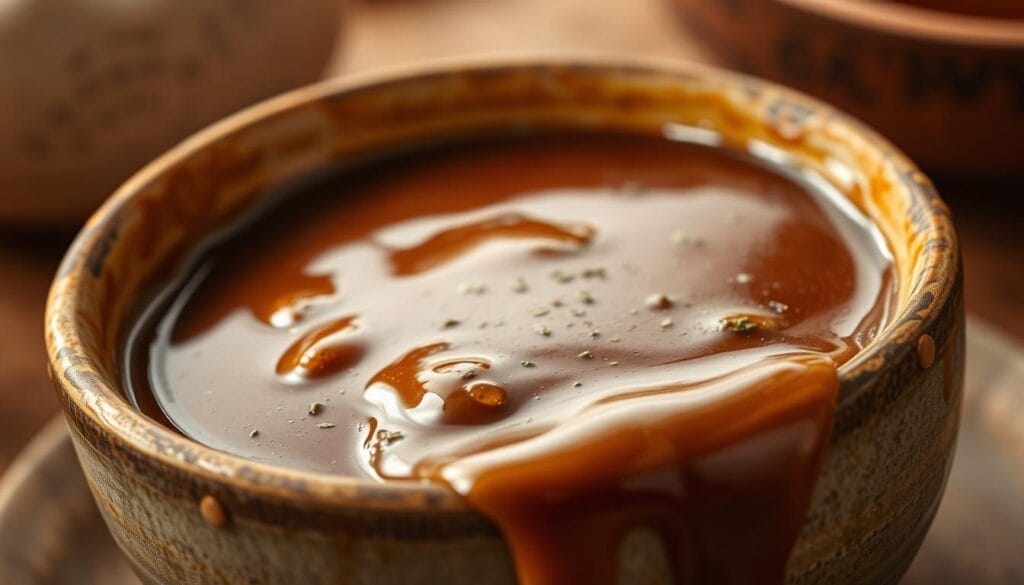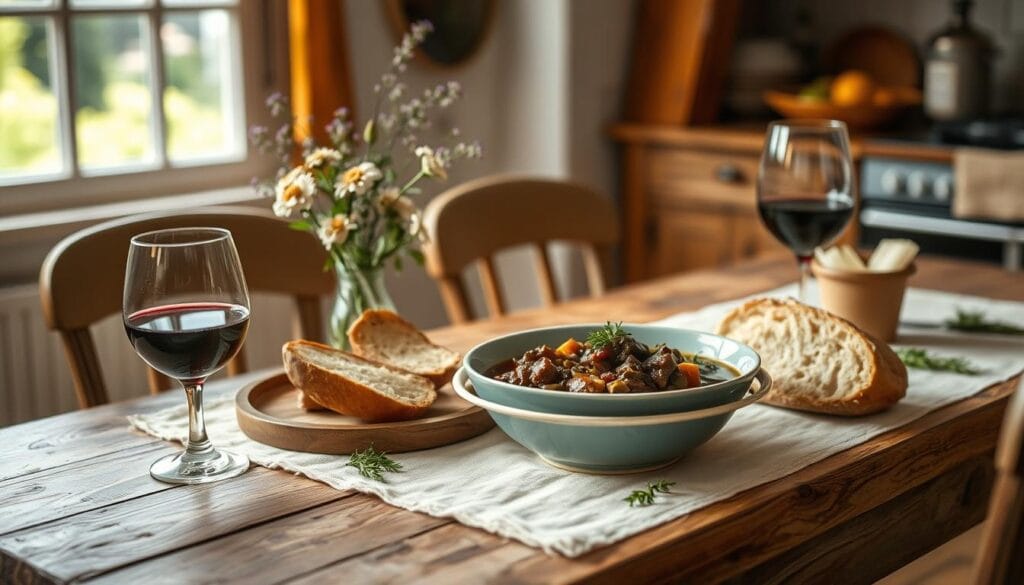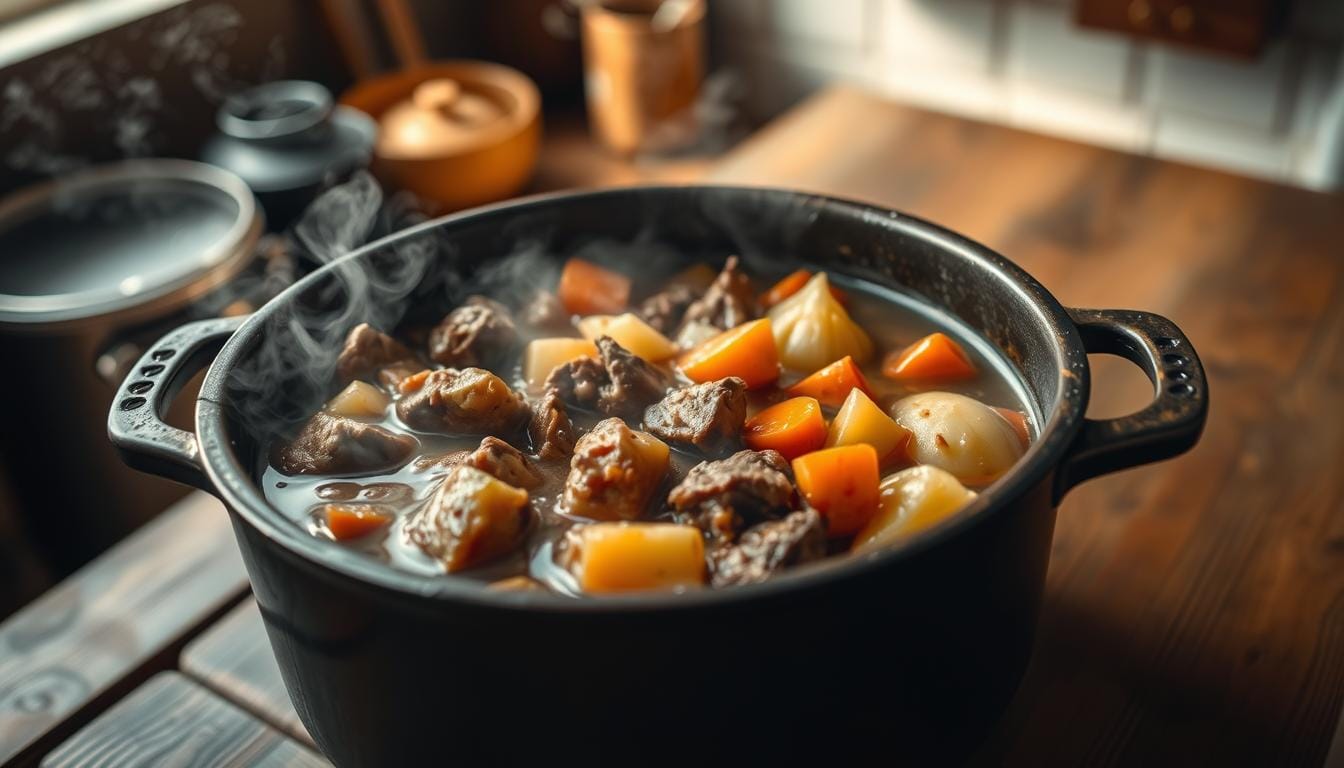How to Make the Perfect Slow Cooker Beef Stew
There’s something special about a hearty, comforting meal that warms the soul. For many, slow cooker beef stew is more than just a meal—it’s a tradition, a comfort, and a way to bring people together. Imagine the aroma of tender beef, fresh vegetables, and rich broth filling your home, creating an inviting atmosphere that feels like a warm hug on a chilly day.
This classic dish is a staple of fall and winter, offering a perfect blend of flavors and textures that never goes out of style. The key to a great slow cooker beef stew lies in its simplicity and the quality of its ingredients. With a focus on tender beef, crisp vegetables, and a deep, savory broth, this recipe ensures a meal that’s both nourishing and delicious.
Table of Contents
What makes this recipe stand out is the attention to detail. From the initial searing of the beef to the slow cooking process, every step is designed to enhance the flavor and texture. The result is a dish that’s not only mouthwatering but also satisfying, making it a go-to for family dinners or casual gatherin
Introduction to Slow Cooker Beef Stew
Imagine coming home to the inviting aroma of a hearty, comforting meal that’s been simmering all day. Slow cooker beef stew is more than just a meal—it’s a tradition that brings warmth and comfort to any home. This classic dish is perfect for chilly fall and winter days, offering a delicious blend of tender meat, crisp vegetables, and a rich, savory broth.
Overview of the Recipe
This recipe stands out for its simplicity and the quality of its ingredients. The slow cooking process ensures that every bite is packed with flavor. With tender chunks of beef, fresh vegetables, and a deep, umami-rich broth, this stew is both nourishing and satisfying.
Why This Stew is a Comfort Food Classic
The magic lies in the slow cooking method, which enhances the flavors and textures of the ingredients. Specific cuts of beef, like chuck or round, become incredibly tender when cooked low and slow. Seasonal vegetables like carrots, potatoes, and celery add natural sweetness and crunch, while red wine and broth create a hearty, comforting base.
| Ingredients | Cooking Method | Benefit |
|---|---|---|
| Tender beef chunks | Slow cooking | Enhances flavor and texture |
| Seasonal vegetables | Low heat for 8 hours | Preserves nutrients and color |
| Red wine and broth | Simmering | Deepens the umami flavor |
This stew is a timeless winter favorite, perfect for family gatherings or cozy nights at home. Its comforting aroma and flavor make it a dish that never goes out of style.
Essential Ingredients for a slow cooker beef stew
Creating a rich and satisfying stew begins with selecting the right ingredients. Each component plays a vital role in crafting a dish that’s both hearty and flavorful.
Quality Cuts of Meat
When it comes to meat, chuck roast or rump roast is ideal. These cuts become tender and juicy when cooked slowly, ensuring every bite is packed with flavor.
Fresh and Flavorful Vegetables
Vegetables like carrots, potatoes, onions, and celery add natural sweetness and texture. These ingredients complement each other beautifully, creating a balanced taste experience.
High-quality ingredients are key to a great stew. They enhance the dish’s natural flavors, ensuring a delicious and satisfying meal every time.
Preparing and Prepping Your Ingredients
Preparation is key to a delicious meal. Taking the time to properly chop, measure, and season your ingredients ensures every component shines.
Chopping and Measuring Tips
Start by chopping vegetables uniformly. Carrots, celery, and onions should be diced into bite-sized pieces. For meat, cut it into even cubes for consistent cooking. Use a digital scale or measuring cups to ensure accuracy—this prevents over-seasoning and maintains balance.
Seasoning Techniques for Maximum Taste
Seasoning is an art. Sprinkle salt and pepper evenly over meat and veggies. Let the meat sit for 5-10 minutes to absorb flavors. Mix herbs and spices in a small bowl, then coat ingredients uniformly. This step is crucial for a robust taste.
| Ingredient | Prep Time | Measurement |
|---|---|---|
| Vegetables | 15 minutes | 2 cups |
| Meat | 10 minutes | 1 cup |
| Seasonings | 5 minutes | ½ cup |
Efficient prep streamlines cooking. Chop, measure, and season with care to build a flavorful foundation. Remember, precise timing and a bit of patience make all the difference in creating a memorable dish.
Searing the Meat for Maximum Flavor
Searing meat is a crucial step that elevates your dish from ordinary to extraordinary. This technique creates a flavorful crust on the meat, which adds depth and richness to your stew. By understanding how to sear effectively, you can take your cooking to the next level.
Browning the Beef Effectively
To achieve a perfect brown crust, heat a skillet over medium-high heat. Add a small amount of oil to the skillet and let it heat up for a minute. Pat the meat dry with paper towels to remove excess moisture, which helps create a better sear. Place the meat in the skillet, being careful not to overcrowd it. Let it cook for 2-3 minutes on each side, or until a nice brown crust forms. Repeat this process with all the meat pieces.
The Role of Flour Coating in Enhancing Taste
A light coating of flour on the meat can make a big difference. The flour helps create a crispy texture and enhances the flavor of the meat. Simply dredge the meat pieces in a plate of flour, shaking off any excess. This step is optional but highly recommended for a more robust taste. Once the meat is browned, remove it from the skillet and set it aside. Leave the drippings in the skillet, as they will add more flavor to your stew.
- Use a hot skillet to achieve the best results.
- Add the right amount of oil to prevent sticking.
- Don’t move the meat too much while it’s browning.
- A light flour coating helps create a flavorful crust.
Mastering the Slow Cooker Beef Stew
Achieving the perfect slow cooker beef stew is all about mastering time and temperature. This section will guide you through setting up your cooker and optimizing the cooking time for tender, flavorful results.
Setting Your Cooker and Temperature Control
Start by setting your slow cooker to the low heat setting. This ensures a gentle simmer that breaks down the connective tissues in the meat, making it tender. If you prefer a quicker cooking time, you can use the high setting, but low heat is recommended for the best results.
Optimizing Cooking Time for Tender Meat
Cooking time is crucial for achieving tender meat. For low heat, cook the stew for 8-10 hours. This extended period allows the flavors to meld together and the meat to become melt-in-your-mouth tender. If you’re short on time, 4-6 hours on high heat will still yield delicious results, though the texture may not be as tender.
- Low heat setting for 8-10 hours ensures tender meat and rich flavors.
- High heat setting for 4-6 hours offers a quicker option with slightly firmer texture.
| Cooking Setting | Time | Result |
|---|---|---|
| Low Heat | 8-10 Hours | Tender meat, rich flavor |
| High Heat | 4-6 Hours | Faster cooking, slightly firmer texture |
By following these guidelines, you’ll be able to create a hearty, comforting slow cooker beef stew that’s perfect for any occasion. Remember, patience is key when it comes to slow cooking—let the cooker do the work and enjoy the delicious results!
Achieving a Rich and Umami Gravy
Creating a rich, umami-packed gravy is the crowning glory of your stew. It’s where all the flavors come together to create that perfect, velvety sauce everyone craves. In this section, you’ll learn how to craft a gravy that’s both deep in flavor and visually appealing.
Deglazing the Pan for Deep Flavor
Deglazing is a simple yet powerful technique that unlocks the full potential of your dish. After searing the meat, those caramelized bits stuck to the pan are packed with flavor. To deglaze, add a small amount of liquid—like red wine or broth—to the hot pan, scraping up all the browned residue with a wooden spoon. This step adds an incredible depth to your sauce, making it more complex and satisfying.

Incorporating Red Wine or Substitutes
Red wine is a classic choice for enhancing the color and flavor of your gravy. It adds a rich, fruity undertone and a slight acidity that balances the dish. If you prefer not to use wine, substitutes like balsamic vinegar or a mixture of beef broth and soy sauce work well. These alternatives provide a similar depth without the wine, ensuring your sauce remains flavorful and balanced.
- Deglaze the pan to capture caramelized bits for added depth.
- Use red wine or substitutes to enhance color and flavor.
- Balance acidity and richness for a harmonious taste.
Mastery of these techniques ensures your stew has a truly indulgent, umami-packed gravy that elevates the entire dish. By following these steps, you’ll create a sauce that’s as delicious as it is visually appealing, making your meal unforgettable.
Customizing Your Recipe with Creative Swaps
Take your dish to the next level by experimenting with creative ingredient swaps. Whether you prefer chicken or want to add extra vegetables, these tweaks can make your meal uniquely yours while keeping it comforting.
Optional Vegetables and Herbs
Swapping beef for chicken is a great way to change things up. Chicken adds a lighter touch and cooks faster, making it a perfect option for a quicker meal. You can also add more vegetables like peas, which bring a burst of freshness and color to the dish.
For a sweeter note, a touch of sugar can balance the flavors beautifully. Consider adding mushrooms or turnips for extra texture and flavor. These small changes can create delightful new combinations that keep your meal exciting.
- Swap beef for chicken for a lighter, faster option.
- Add peas for freshness and color.
- Incorporate mushrooms or turnips for texture.
- Use a touch of sugar to balance flavors.
- Experiment with herbs and garnishes for a personal touch.
These simple swaps let you enjoy a comforting meal with your own unique twist. Whether it’s chicken, peas, or a hint of sugar, every change brings new flavors to savor.
Serving Suggestions for the Perfect Meal
Transform your meal into a memorable experience with these serving suggestions. The right sides and presentation can elevate your dish, making it a true delight for both the eyes and the palate.
Pairing Sides: Bread, Noodles, and More
Complement your hearty stew with crusty bread or buttery noodles for a satisfying meal. These options soak up the flavorful broth perfectly. For a lighter touch, try serving with a fresh veggie medley or a crisp green salad.

These pairings enhance the stew’s rich flavors, creating a balanced and delicious meal. Whether you prefer classic comfort or a fresh twist, there’s a side to suit every taste.
Presentation and Garnishing Ideas
Add a touch of elegance with simple garnishes. Fresh herbs like parsley or thyme, or a dollop of yogurt, can make your dish visually appealing. Creative plating turns a homey meal into a restaurant-worthy presentation.
| Side Dish | Cooking Method | Why It Works |
|---|---|---|
| Crusty Bread | Oven-toasted | Absorbs flavorful broth |
| Egg Noodles | Light boiling | Soft texture contrast |
| Roasted Vegetables | Oven-roasted | Earthy flavor complement |
These ideas ensure your meal is both nourishing and visually appealing, making every bite a joy.
How to Store and Reheat Your Stew
Proper storage and reheating are key to keeping your stew fresh and flavorful. Whether you’re refrigerating or freezing, using airtight containers is essential to preserve the rich flavors and textures of your dish.
Refrigeration and Freezing Guidelines
For short-term storage, your stew can be kept in the refrigerator for up to 4 days. Use an airtight container to prevent any cross-contamination of flavors. If you plan to store it longer, freezing is the best option. Place the stew in a freezer-safe container or bag, where it will keep for up to 3 months. Always label the container with the date so you can easily keep track of how long it’s been stored.
Effective Reheating Methods for Retained Flavor
Reheating your stew is simple and can be done in a few ways. For a quick method, use the microwave, stirring every 30 seconds until heated through. For a more traditional approach, reheat it on the stovetop over low heat, stirring occasionally. If you prefer using a slow cooker, reheat it on the low setting for 1-2 hours. To enhance the texture, you can add a slurry made from flour and water to thicken the stew if needed.
By following these storage and reheating tips, your stew will remain as delicious as the day it was made. Proper handling ensures that every bite continues to be a delightful experience.
Conclusion
There’s nothing quite like a warm, comforting bowl of homemade stew to brighten up a chilly day. This recipe brings together tender meat, crisp vegetables, and a rich broth, all slow-cooked to perfection. The slow cooker method ensures every bite is flavorful and satisfying, making it a perfect addition to your weekly menu during the colder months.
Feel free to experiment with ingredients to make the dish your own. Whether you add extra vegetables or a sprinkle of black pepper for extra flavor, every customization enhances the experience. Serve it alongside crusty bread or a fresh salad for a well-rounded meal.
Share this hearty dish with family and friends, and enjoy the warmth it brings to your table. With proper storage, you can savor it for days, making it a convenient and delicious option any time of the year.
FAQ
How long does it take to cook stew in a slow cooker?
What vegetables work best in a hearty stew?
Can I use red wine if I don’t have it on hand?
How do I ensure the meat is tender?
Can I refrigerate or freeze the stew after cooking?
What if I prefer a thicker gravy?
Is it necessary to sear the meat before slow cooking?
Can I add other seasonings or spices?
How should I serve the stew for the best presentation?
have you tried our recipe?
There are no reviews yet. Be the first one to write one.


